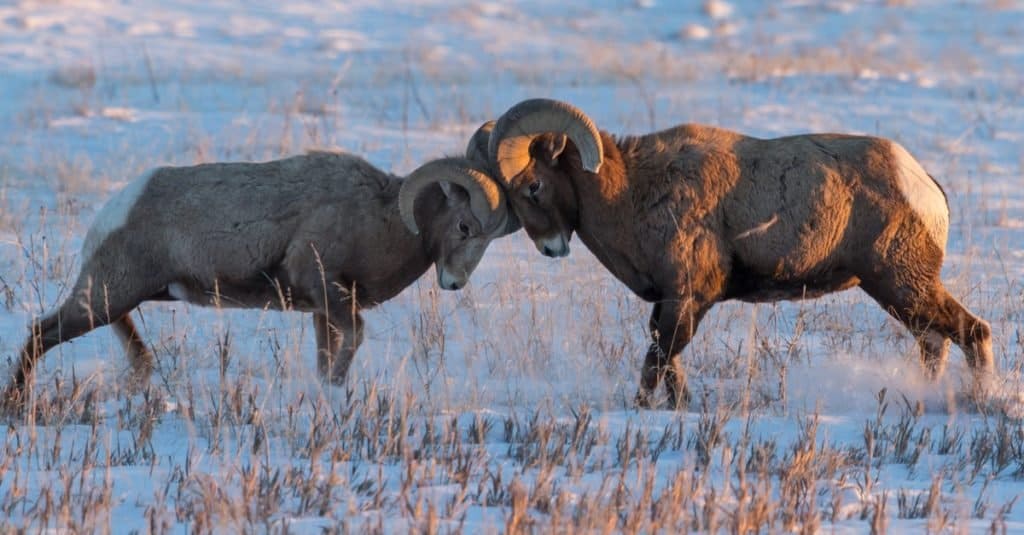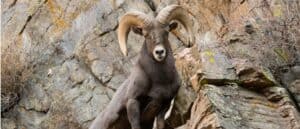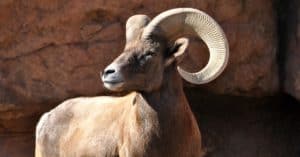The bighorn sheep, or Ovis canadensis, is an indigenous North American sheep species. The bighorn sheep population has a large history. Its name comes from the size of its horns. Currently, O. canadensis is divided into three distinct species. Those subspecies include the Rocky Mountain bighorn, the Sierra Nevada bighorn, and the Desert bighorn.
The Rocky Mountain bighorn sheep lives in the Rocky Mountains of the United States and Canada, as well as the Pacific Northwest. The Sierra Nevada bighorn sheep, formerly known as the California bighorn sheep, is a genetically unique subspecies found solely in the Sierra Nevada mountains of California. Throughout the arid regions of Northwestern Mexico and the Southwestern United States live desert bighorn sheep.
This page will attempt to estimate the bighorn sheep population. Their current conservation status and potential dangers will be discussed as well.
The Number of Bighorn Sheep in the Wild Is…

At the turn of the 19th century, North American bighorn sheep totaled 1.5–2 million. Today there are less than 70,000.
©iStock.com/randimal
Bighorn sheep in the North American region numbered between 1.5 and 2 million at the turn of the nineteenth century, but there are now fewer than 70,000 of them. This is a fourfold rise from when restoration work first began, although it’s still probably at least tenfold lower than pre-restoration levels.
The bighorn sheep population in the Rocky Mountain range between 31,500 and 34,500. This makes them the most numerous and widespread bighorn race. There are populations of them in the U.S. states of Arizona, Colorado, Idaho, Montana, Nebraska, Nevada, New Mexico, Oregon, South Dakota, Utah, Washington, and Wyoming, They are also found in British Columbia and Alberta Canada.
The male Rocky Mountain bighorns can weigh up to 500 pounds and the females over 200 pounds. Male Sierra Nevada bighorns can reach a maximum weight of 198 lb., while females can only reach a maximum weight of 132 lb. Horns on males can weigh as much as 30 pounds, which is more than the total weight of the male’s skeleton!
The bighorn sheep population was common in the western region of the United States, southern Canada, and northern Mexico 200 years ago. The loss was most severe between 1870 and 1950 due to factors like uncontrolled hunting, destruction of habitat, overgrazing, and diseases transmitted by domestic animals.
Where Do You Typically See Bighorn Sheep?

The U.S. and Canada’s cooler alpine regions have Rocky Mountain and Sierra Nevada bighorn sheep.
©iStock.com/Gary Gray
Bighorn sheep of the Rocky Mountains and the Sierra Nevada can be found in the U.S. In addition, this animal can be found in the colder alpine regions of Canada. In contrast, the hot desert environments of Mexico and the Southwestern United States are native territories for the desert bighorn sheep subspecies.
Bighorns like grassy mountain slopes, alpine meadows, and the foothills near cliffs and bluffs to graze on. Because of their inability to traverse deep snow, bighorn sheep are more at home on dryer slopes. Winter habitats for bighorn sheep are typically found at a lower altitude than their summer counterparts.
Is the Bighorn Sheep Facing Extinction?

Despite the population decline, Rocky Mountain bighorn sheep are the “least concern” for conservation.
©John Raptosh/Shutterstock.com
The Sierra Nevada bighorn sheep and the Peninsular bighorn sheep, a subset of the desert bighorn sheep, are in perilous straits. Since the 1940s, numerous federal and state agencies have worked to restore bighorn sheep. However, their efforts have had very modest success, and the vast majority of the bighorns’ historical range is still uninhabited.
Rocky Mountain bighorn sheep nevertheless have a conservation category of “least concern,” despite their population reduction. In both Canada and the United States, hunting of male bighorn sheep is legal, albeit subject to strict regulations. Several states operate drawings or raffles for bighorn ram tags that are open to both residents and non-residents.
Sheep hunting is popular in Montana. The state has earned the nickname “Land of the Giants” because of its large population of bighorn sheep. Since the cost of a hunting tag is so high, most bighorn sheep hunts are led and outfitted. Bighorn sheep are prized by hunters for both their trophic value and their aesthetic.
Which Dangers Do Bighorn Sheep Face?

Two Bighorn sheep rams can be seen battling during the mating season on a snow-covered prairie in this rare image.
©Warren Metcalf/Shutterstock.com
Pneumonia and diseases like scabies that domestic sheep carry can be fatal for bighorn sheep. Additionally, accidents like falling off cliffs (a risk of living in steep, rough terrain) account for further mortality. Bighorns have evolved to thrive in environments with steep slopes, where they can hide from predators.
Bobcats, coyotes, golden eagles, gray foxes, jaguars, lynxes, ocelots, and wolverines are just a few of the predators that target sheep. Bears, wolves, and especially mountain lions pose the greatest danger to bighorn sheep of all ages. This is because they have the agility to prey on them in their rocky, uneven surroundings.
Are Bighorn Sheep Beneficial to Our Planet?

The Sierra Nevada and Peninsular bighorn sheep, a desert subspecies, are in danger.
©iStock.com/Rainbohm
Because of their sensitivity to numerous human-caused environmental concerns, the population of bighorn sheep is widely regarded as reliable markers of land health. The more bighorns, the better our terrains are doing and the better we are at keeping it that way.
The photo featured at the top of this post is © iStock.com/Gary Gray
Thank you for reading! Have some feedback for us? Contact the AZ Animals editorial team.






